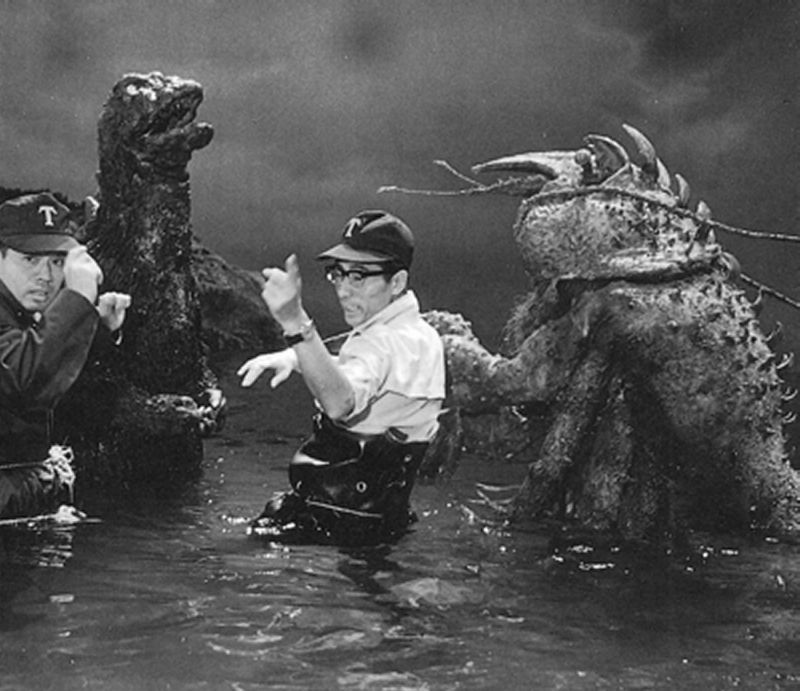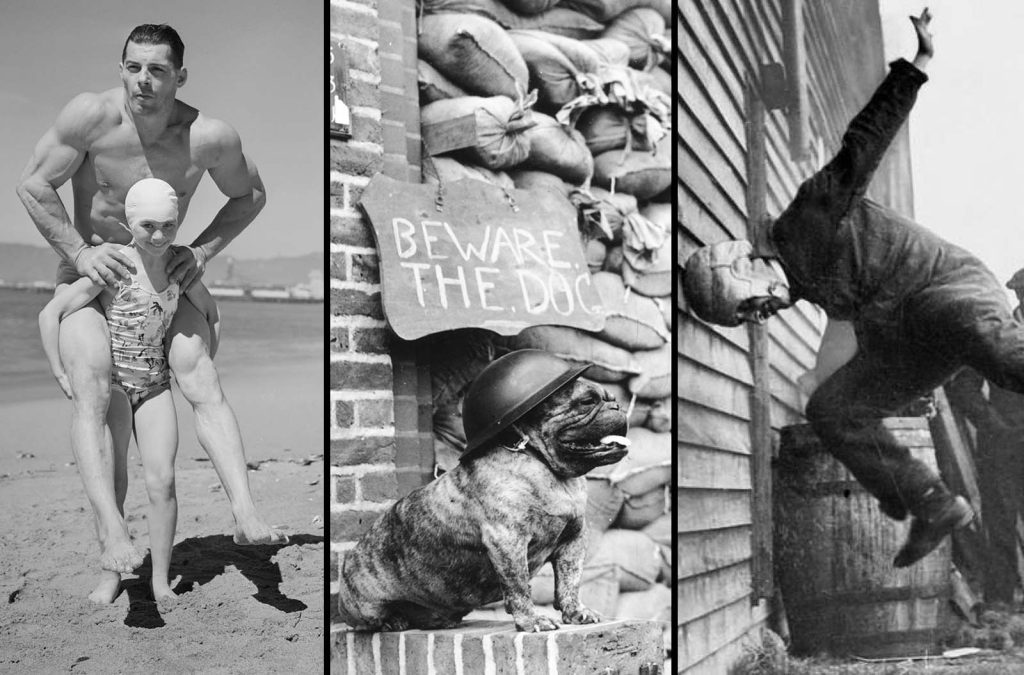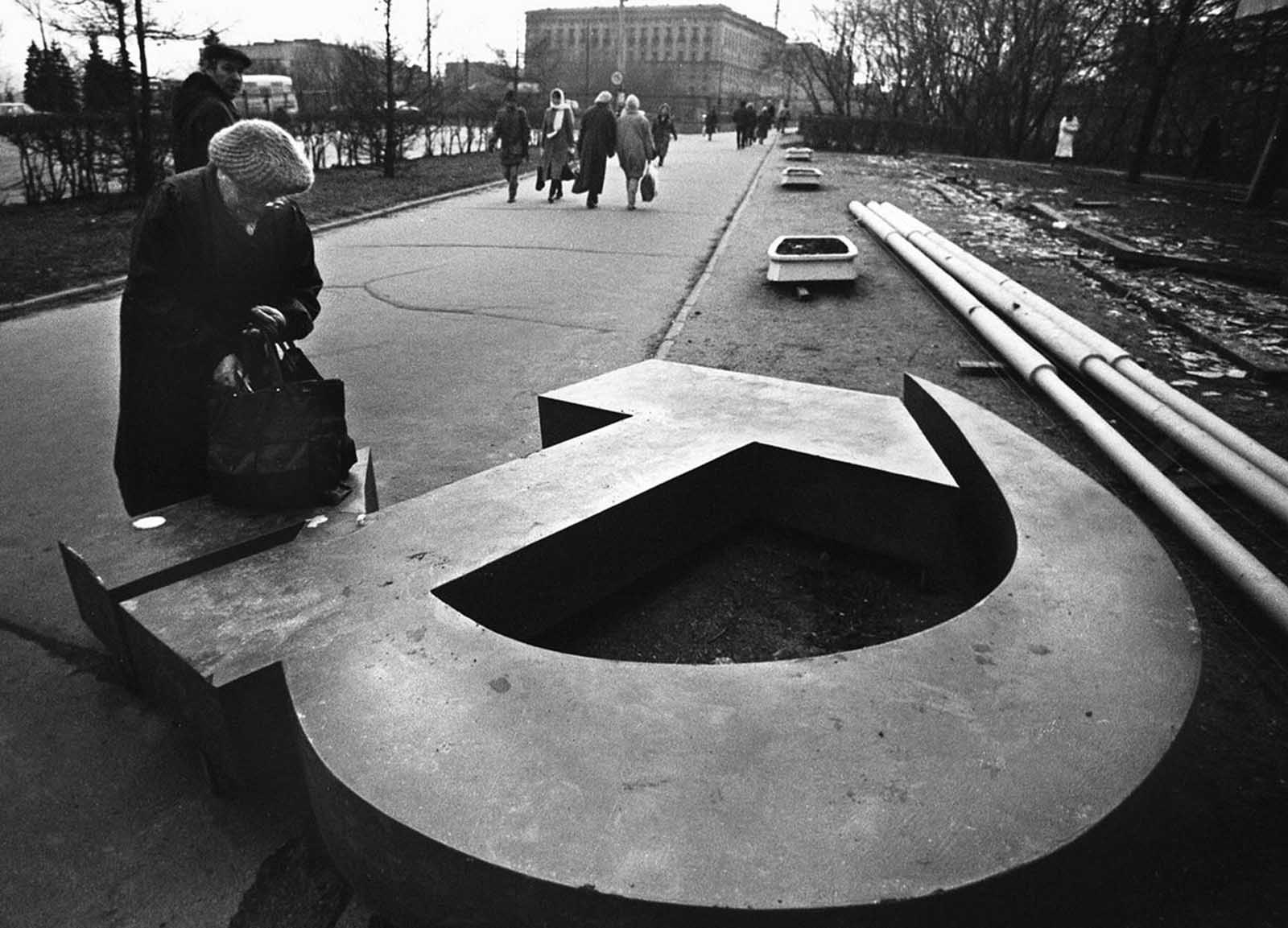On July 15, 1960, Senator John F. Kennedy tells Democratic convention delegates and some 65,000 others in the Los Angeles Coliseum that he will be the party’s candidate for President in the 1960 campaign.
John F. Kennedy was born into a rich, politically connected Boston family of Irish-Catholics. He and his eight siblings enjoyed a privileged childhood of elite private schools, sailboats, servants, and summer homes.
During his childhood and youth, “Jack” Kennedy suffered frequent serious illnesses.
Nevertheless, he strove to make his own way, writing a best-selling book while still in college at Harvard and volunteering for hazardous combat duty in the Pacific during World War II. Kennedy’s wartime service made him a hero.
After a short stint as a journalist, Kennedy entered politics, serving in the U.S. House of Representatives from 1947 to 1953 and the U.S. Senate from 1953 to 1961.
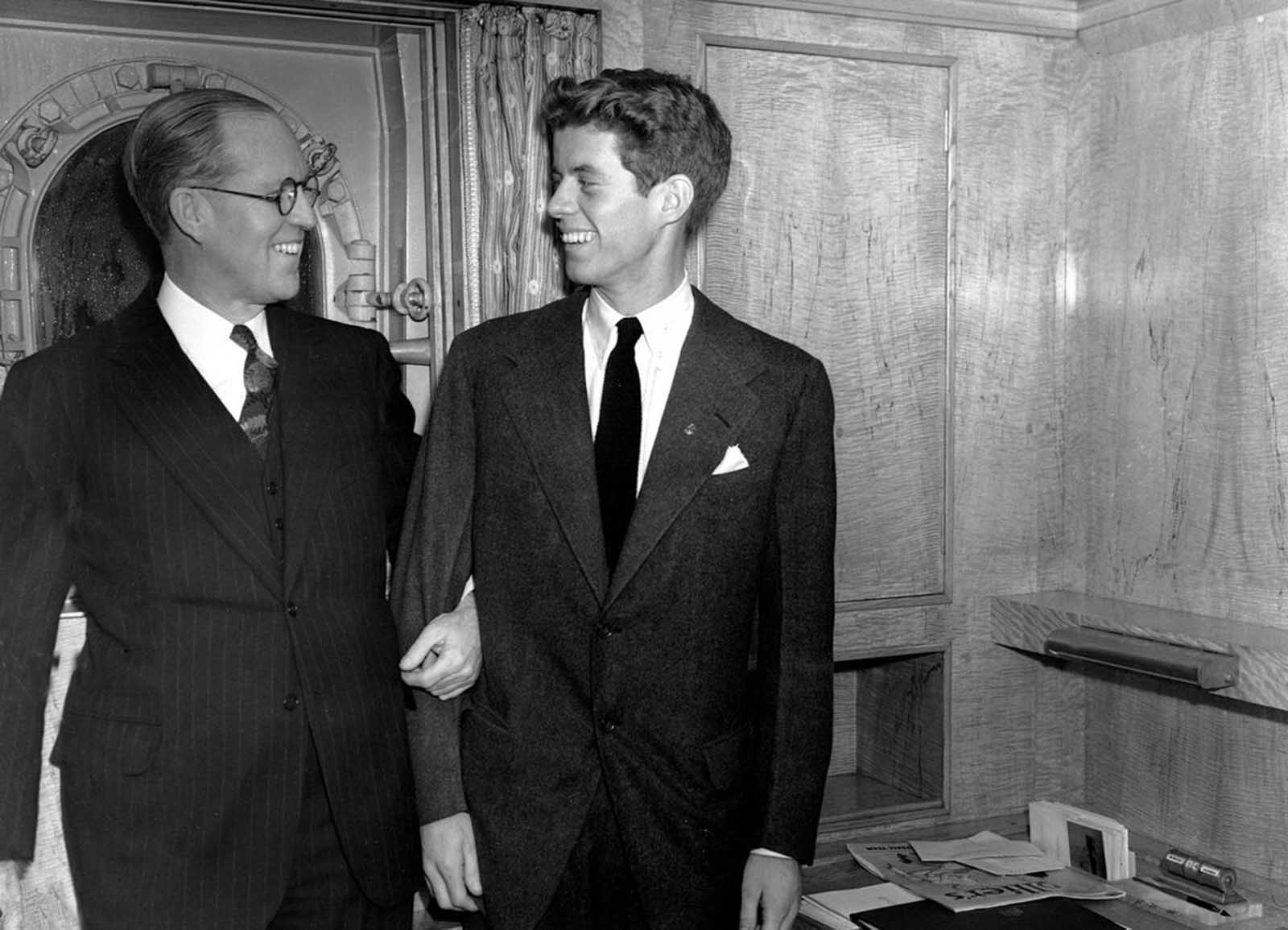
In this January 5, 1938 file photo, Joseph P. Kennedy, left, U.S. Ambassador to Great Britain, stands with his 20 year old son, John F. Kennedy, in New York. Kennedy was the second son, and one of nine children, of business tycoon Joseph P. Kennedy. When first son Joseph Jr. was killed during World War II, John became the designated heir.
Kennedy was the youngest person elected U.S. President and the first Roman Catholic to serve in that office.
For many observers, his presidency came to represent the ascendance of youthful idealism in the aftermath of World War II.
The promise of this energetic and telegenic leader was not to be fulfilled, as he was assassinated near the end of his third year in office.
For many Americans, the public murder of President Kennedy remains one of the most traumatic events in memory—countless Americans can remember exactly where they were when they heard that President Kennedy had been shot.
His shocking death stood at the forefront of a period of political and social instability in the country and the world.

Elected to the U.S. Senate in 1952, here, Senator John F. Kennedy, accompanied by Dick Mayer, 15, and Melissa Tyler, 14, of Shrewsbury, Massachusetts inspects tornado damage in Shrewsbury, on June 10, 1953. At least 86 were left dead in the area by the tornado, 800 injured and 2,500 made homeless.

Senator John F. Kennedy greets President Dwight D. Eisenhower on his arrival for festivities at the National Corn Picking Contest near Cedar Rapids, Iowa, on October 17, 1958.
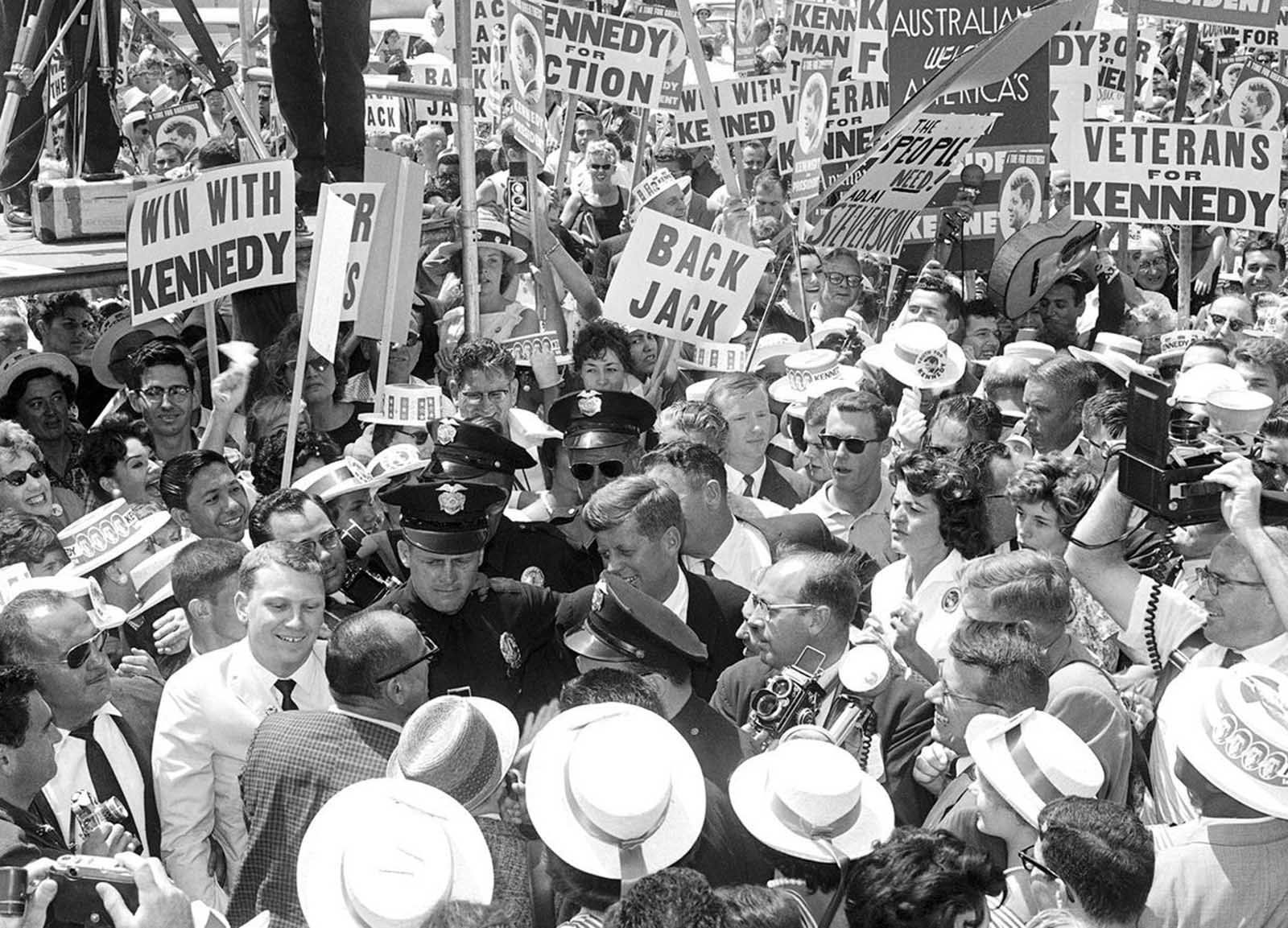
Sen. John F. Kennedy is mobbed by well wishers carrying Kennedy banners on his arrival at Los Angeles International Airport, on July 9, 1960 to personally lead his drive for the Democratic presidential nomination.
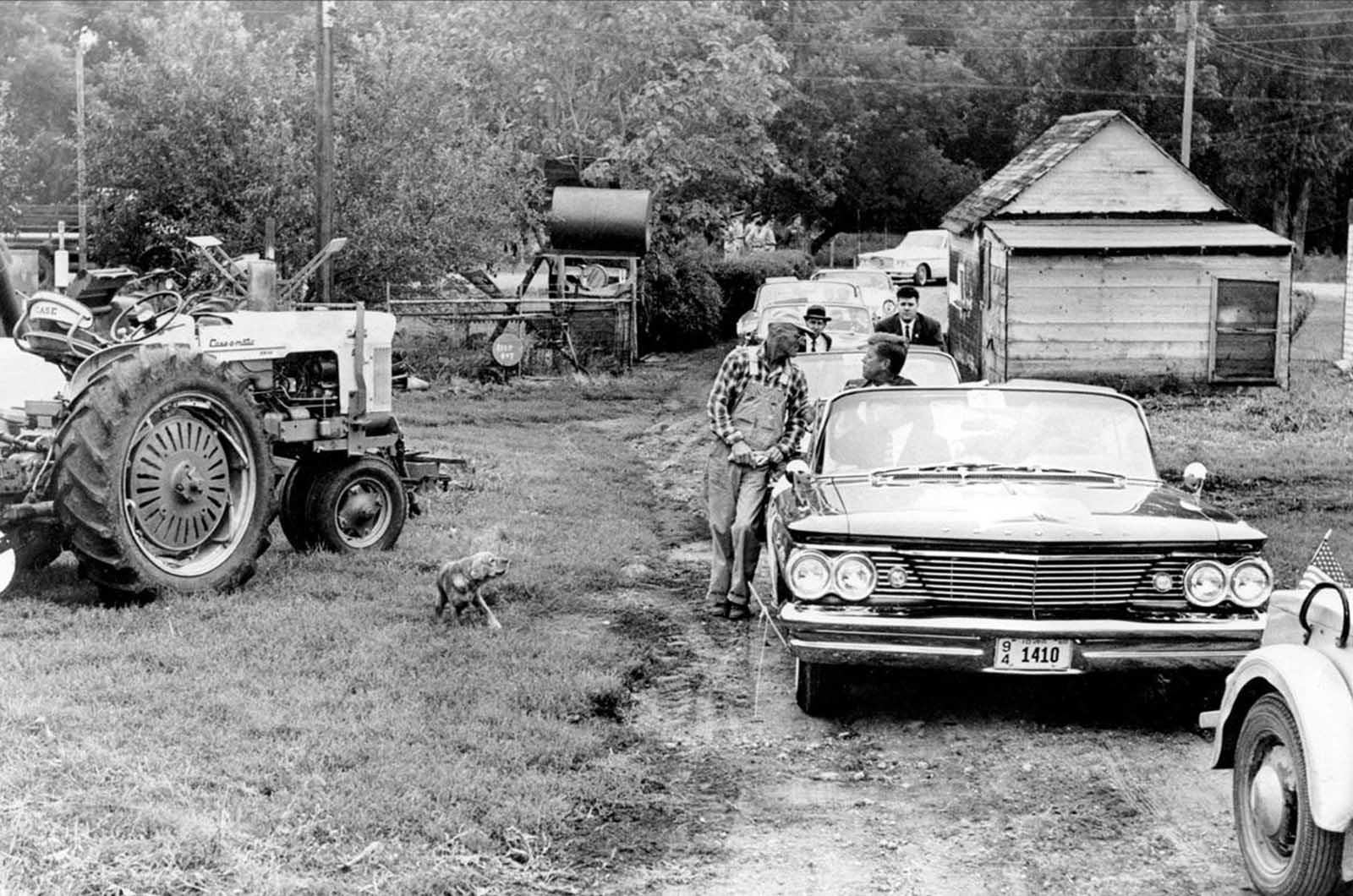
Democratic Presidential nominee Sen. John F. Kennedy, in backseat of Pontiac convertible, talks with farmer James Cox during his campaign visit to the farm in Fort Dodge, Iowa, on September 22, 1960.
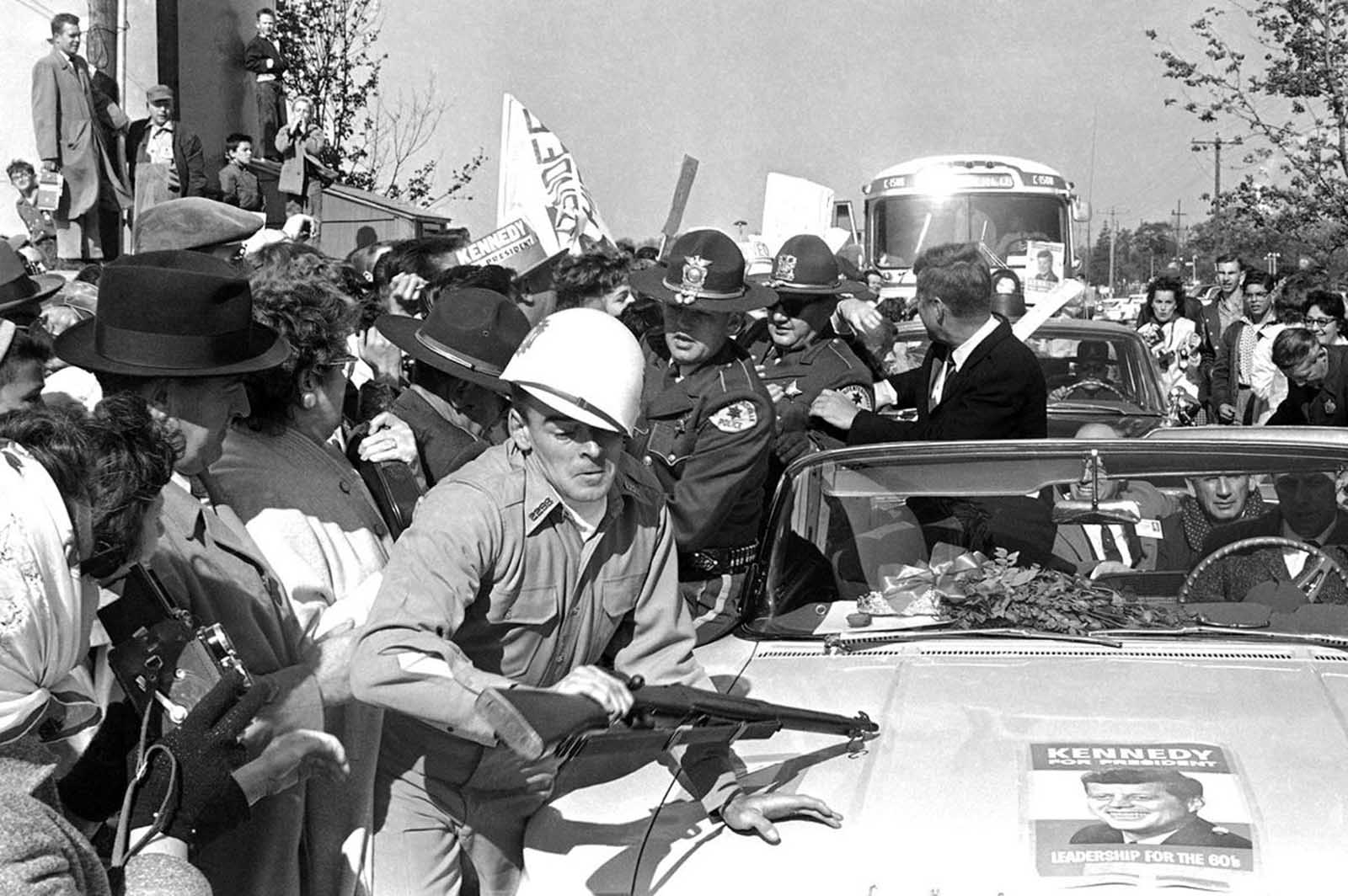
Helmet askew, rifle definitely not at the ready, man in military uniform is jammed against fender of car bearing the Democrats’ presidential nominee, on October 25, 1960 in Elgin, Illinois.

Sen. John F. Kennedy stands on the hood of a truck to acknowledge the cheers of thousands who greeted him in a garment workers rally in downtown Los Angeles, on November 1, 1960.
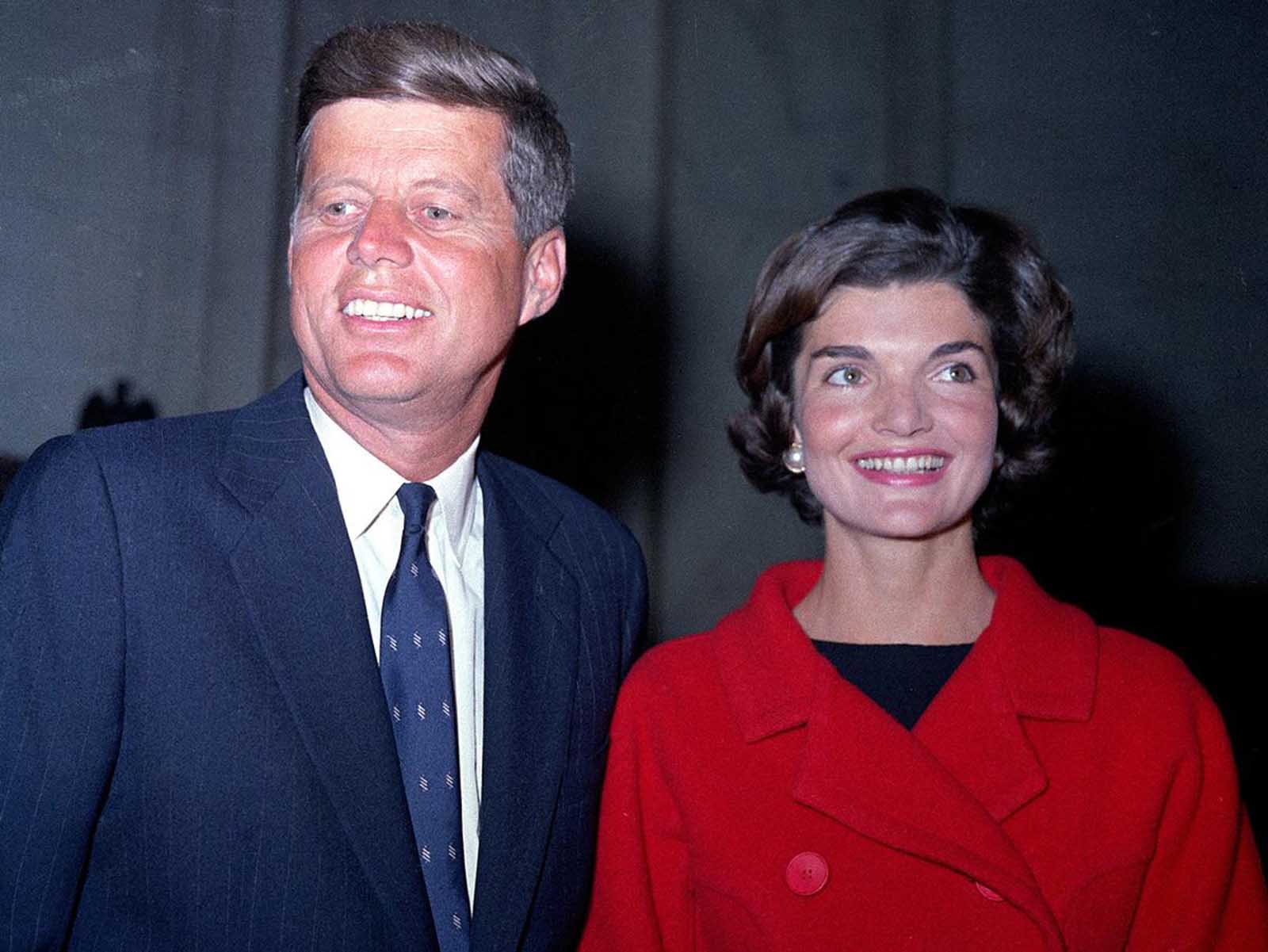
A November 1960 photo of John F. Kennedy and his wife Jacqueline Kennedy.
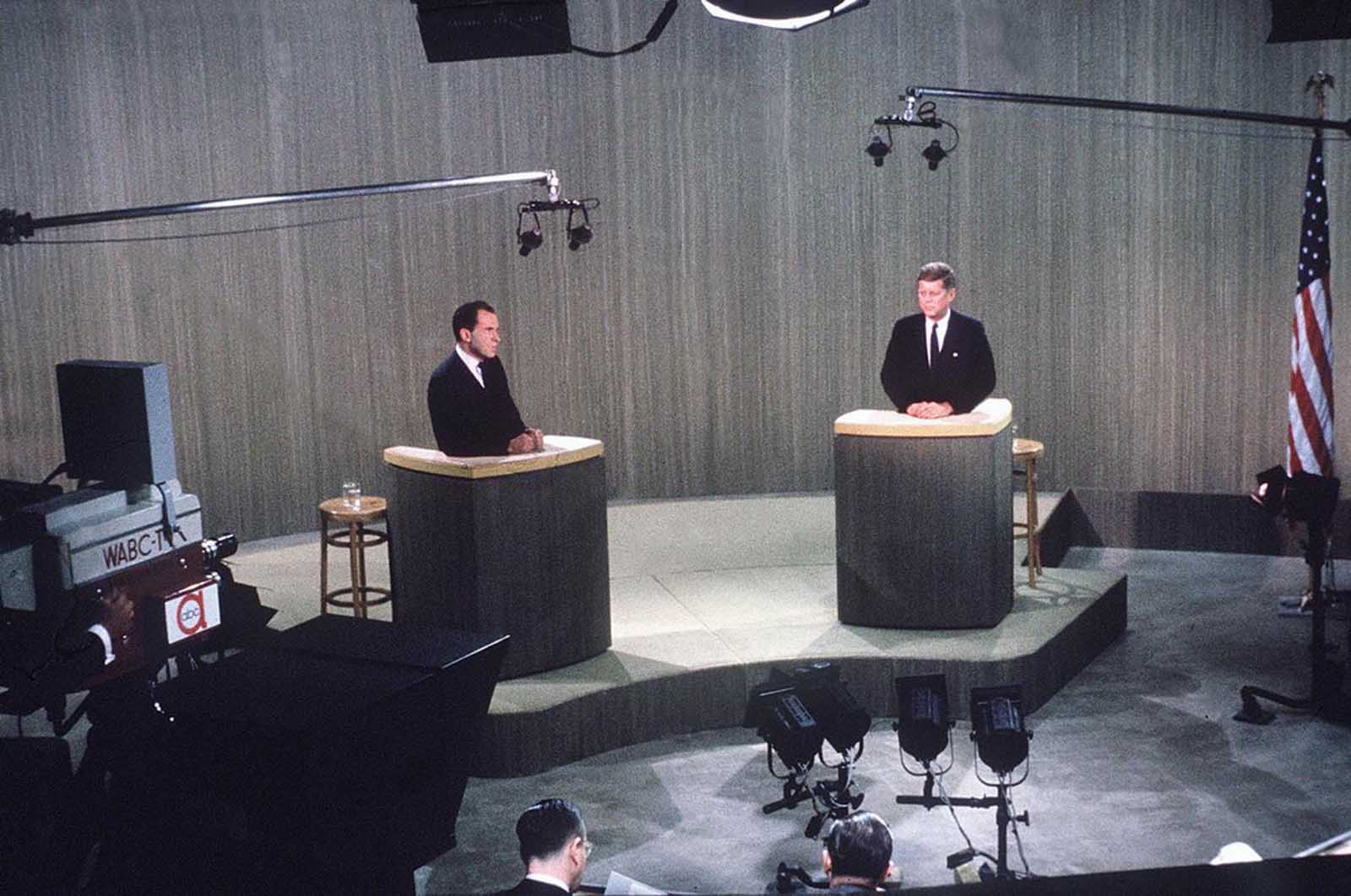
Republican Vice President Richard M. Nixon, left, debates Sen. John F. Kennedy, the Democratic presidential nominee, during a live broadcast from a New York television studio of their fourth presidential debate on October 21, 1960.

Jacqueline Kennedy, left center, sits in her living room with a group of Democrats watching her husband on television, debating domestic affairs with Vice President Richard Nixon, at her Hyannis Port, Massachusetts, home, on September 26, 1960.

Senator John F. Kennedy, (lower right), grins happily as backers cheer the Democratic presidential candidate in Minneapolis, on October 1st. Kennedy was leaving his hotel for a rally and was surrounded by a large crowd of partisans on October 2, 1960. They waved banner threw confetti and yelled heartily. Between 18,000 and 20,000 attended the rally and thousands more were turned away.

After winning the election in 1960, President John F. Kennedy, delivers his Inaugural Address in Washington, District of Columbia, on January 20, 1961.

Mrs. Jacqueline Kennedy has a chuck under the chin for her husband moments after he became president, on January 20, 1961. This exclusive picture by AP photographer Henry Burroughs was taken in the rotunda of the Capitol just after President John F. Kennedy left the inaugural stand.

President John F. Kennedy addresses Congress in Joint Session for his first state of The Union Address in Washington, on January 31, 1961.
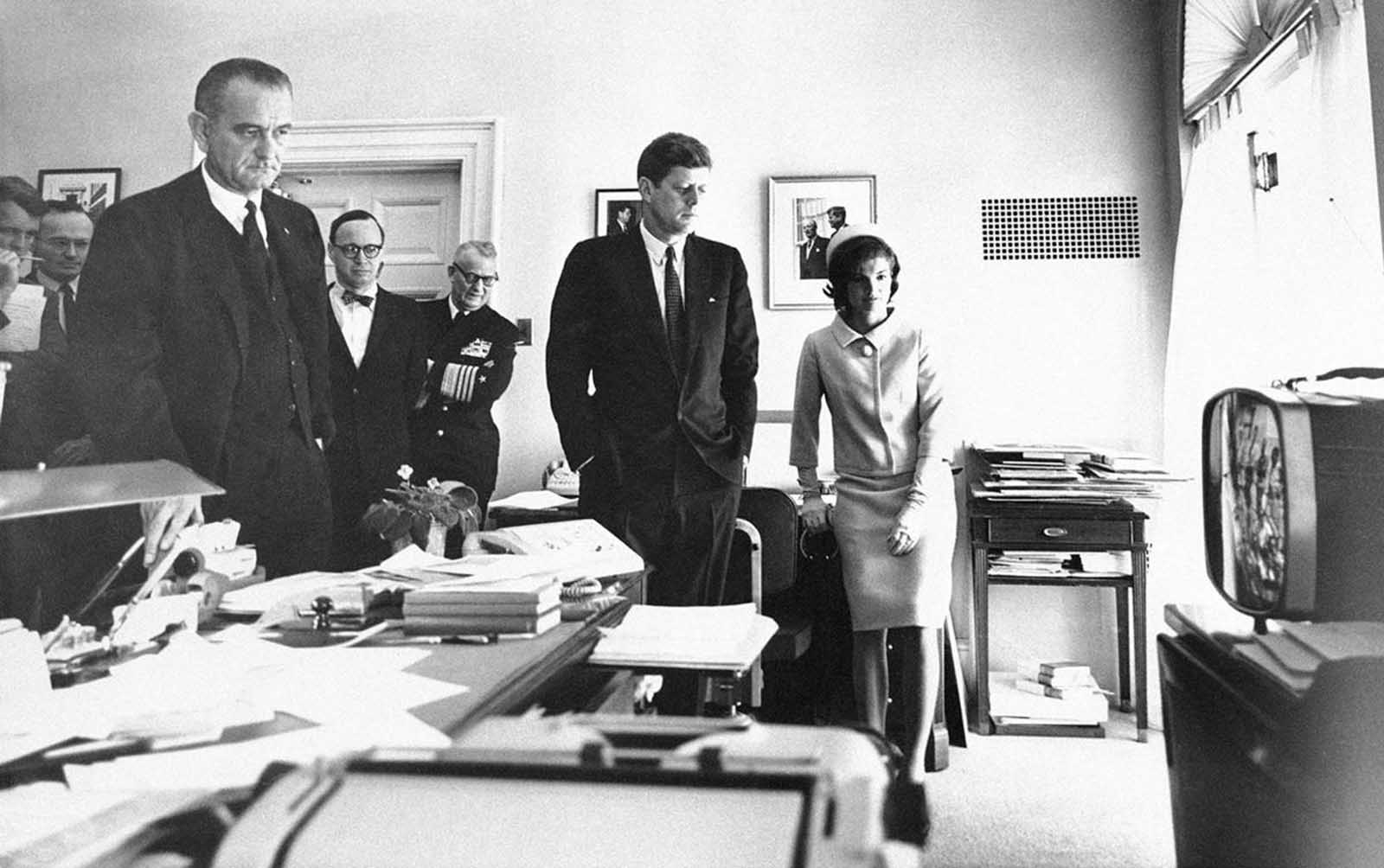
President Kennedy and Mrs. Jacqueline Kennedy follow the takeoff and space flight of Astronaut Alan Shepard on television. Others, watching from the White House office of the Chief Executive’s secretary in Washington, on May 5, 1961, are, from left: Attorney General Robert Kennedy; McGeorge Bundy, presidential assistant; Vice President Lyndon Johnson; Arthur Schlesinger Jr., another presidential assistant, and Chief of Naval Operations Adm. Arleigh Burke.
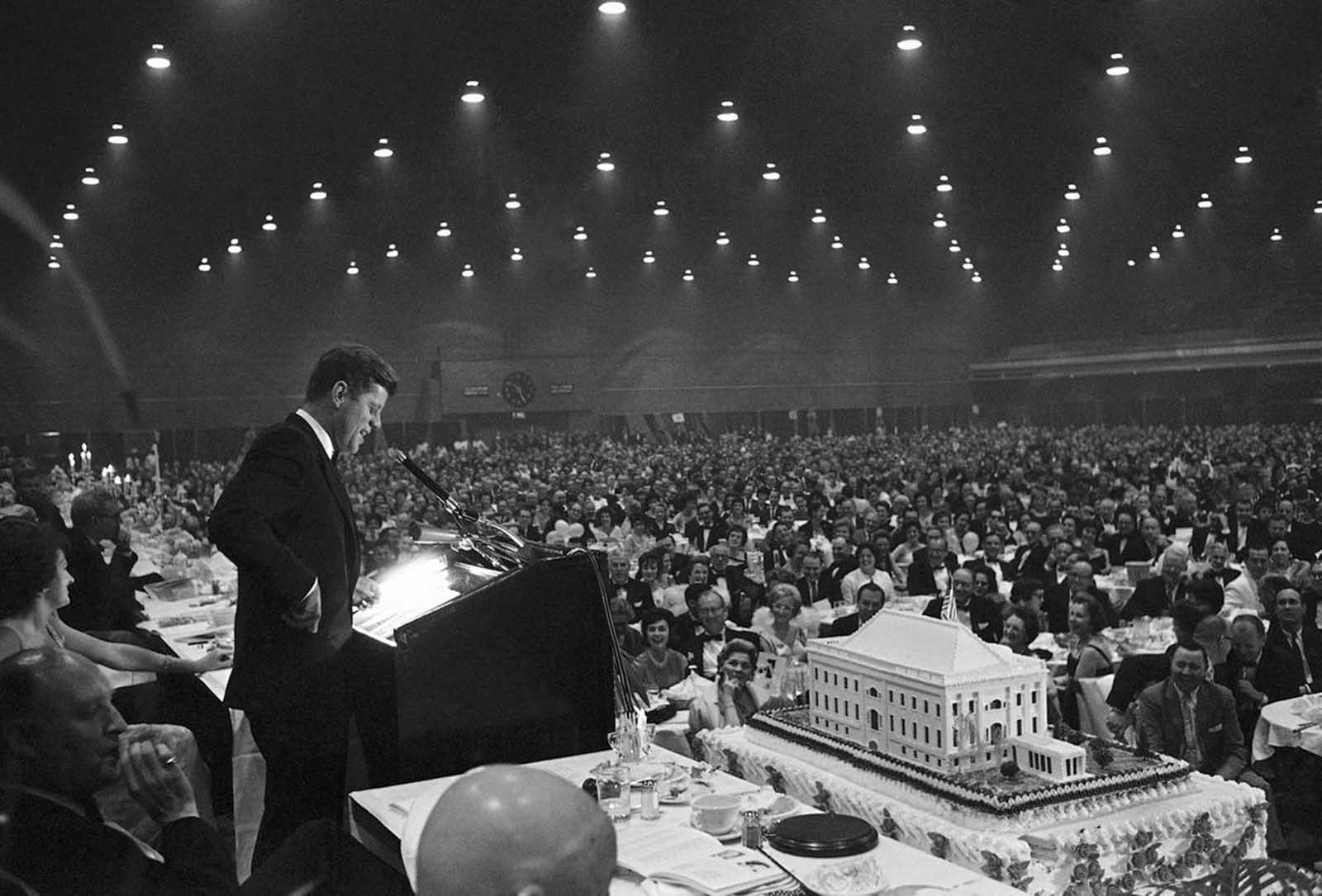
President Kennedy smiles as he delivers a joking remark to the 6,000 attending the $100-a-plate Democratic dinner on May 27, 1961 in Washington?s National Guard Armory, to help him celebrate his 44th birthday. The cake in foreground weights 1.5 tons and is topped by a replica of the White House.

President Kennedy speaks to reporters at a nationally televised news conference in the State Department auditorium, on March 23, 1961. The Chief Executive at the opening of the conference discussed the Laos situation and used three different maps, picturing how pro-communist rebels have gained ground in the last seven months in Laos. The map at left was used by Kennedy to Show communist rebel areas as of March 22 which, he said, are indicated by the dark and shaded portions

Three-year-old Caroline Kennedy pushes past her father as he leaves the elevator at the White House ground floor, on March 16, 1961, to begin a typical busy day at 9:42 A.M. President Kennedy has a strip of tape across a cut above his left eye, suffered when his head struck a table as he was bending over to pick up something for Caroline.

President Kennedy sits at his White House office desk, on June 6, 1961 as he reports to the nation by television and radio networks, on his talks with Soviet Premier Nikita Khrushchev in Vienna and President Charles de Gaulle of France in Paris.

President John Kennedy, right, and his wife, Jacqueline, wearing bathing suit, stand on a pier after spending the afternoon boating on Nantucket Sound at Hyannis Port, Massachusetts, on August 5, 1961. The President and U.N. Ambassador Adlai E. Stevenson conferred aboard his yacht during the cruise.

President John F. Kennedy heads for Washington after an overnight stopover on December 18, 1961 in West Palm Beach, Florida where he rested after his Latin American tour due to a heavy cold.

Astronaut John Glenn and President John Kennedy inspect the Friendship 7, the Mercury capsule which Glenn rode in orbit. Kennedy presented the Distinguished Service Medal to Glenn on February 23, 1962 at Cape Canaveral, Florida.

President Kennedy starts a windup for the pitch to open the American League baseball season, on April 8, 1962, in Washington.

U.S. President John F. Kennedy and Mexican President Adolfo Lopez Mateos are showered with tons of confetti and paper, on June 29, 1962, as they travel down one of Mexico City’s boulevards shortly after Kennedy’s arrival for a three-day visit.

President Kennedy claps to keep time as his children Caroline and John, Jr. dance in the Oval Office, in October of 1962.
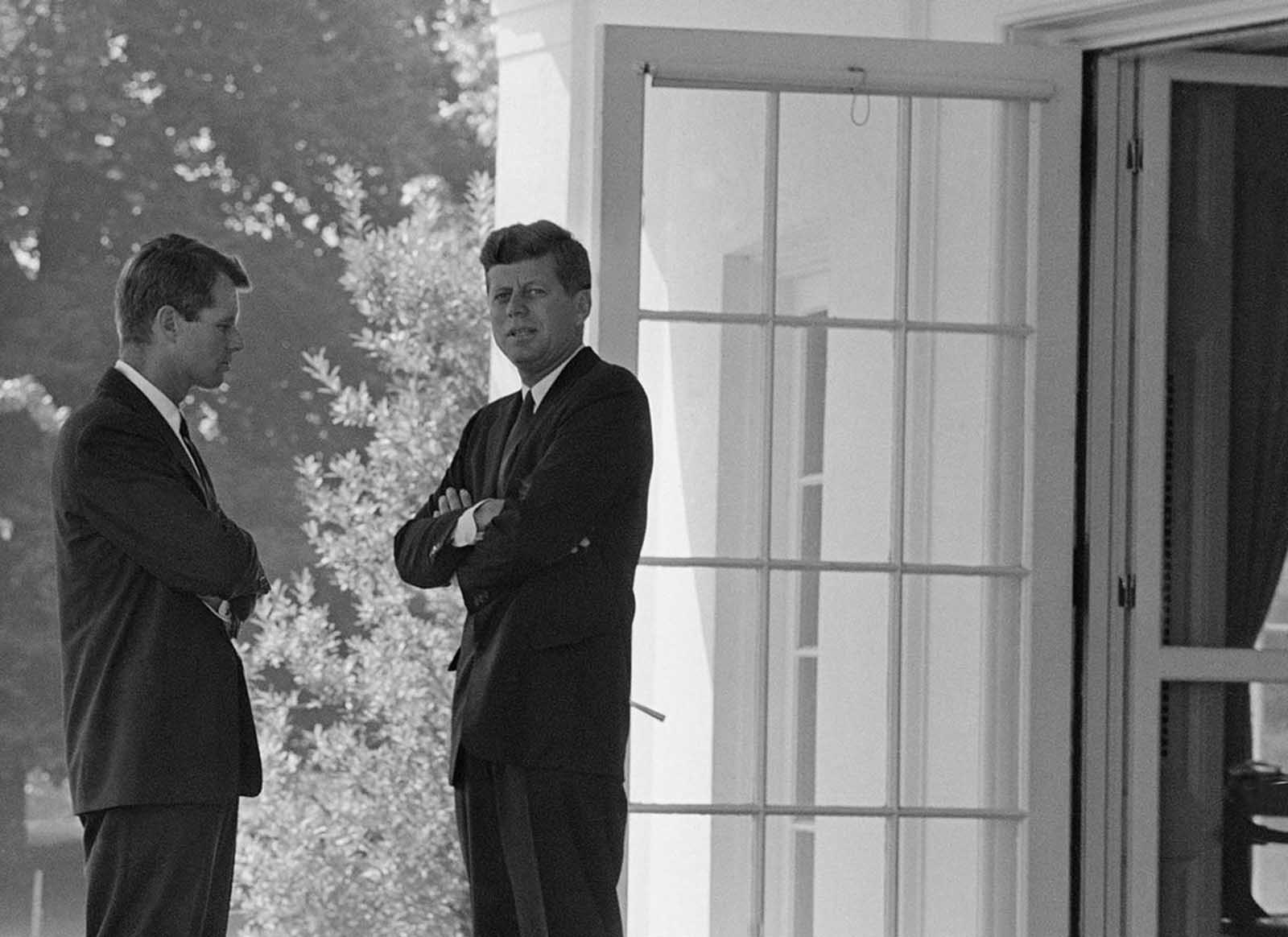
President Kennedy confers with his brother, Attorney General Robert F. Kennedy, at the White House in Washington, District of Columbia, on October 1, 1962 during the buildup of military tensions between the U.S. and the Soviet Union that became Cuban missile crisis later that month.
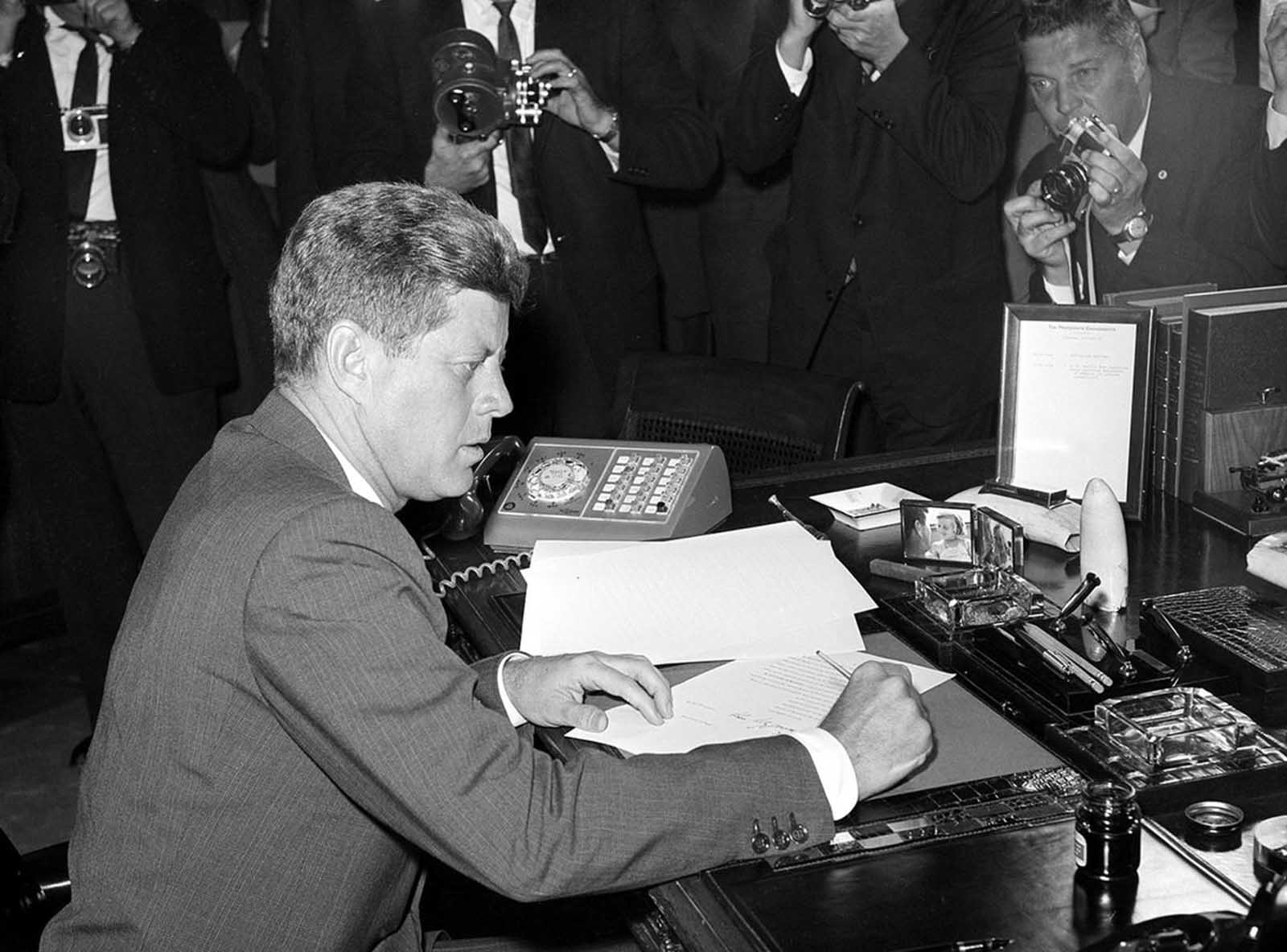
President Kennedy is surrounded by photographers as he sits at his desk in the White House, on October 23, 1962, shortly after signing a presidential proclamation concerning the Cuba Missile crisis.
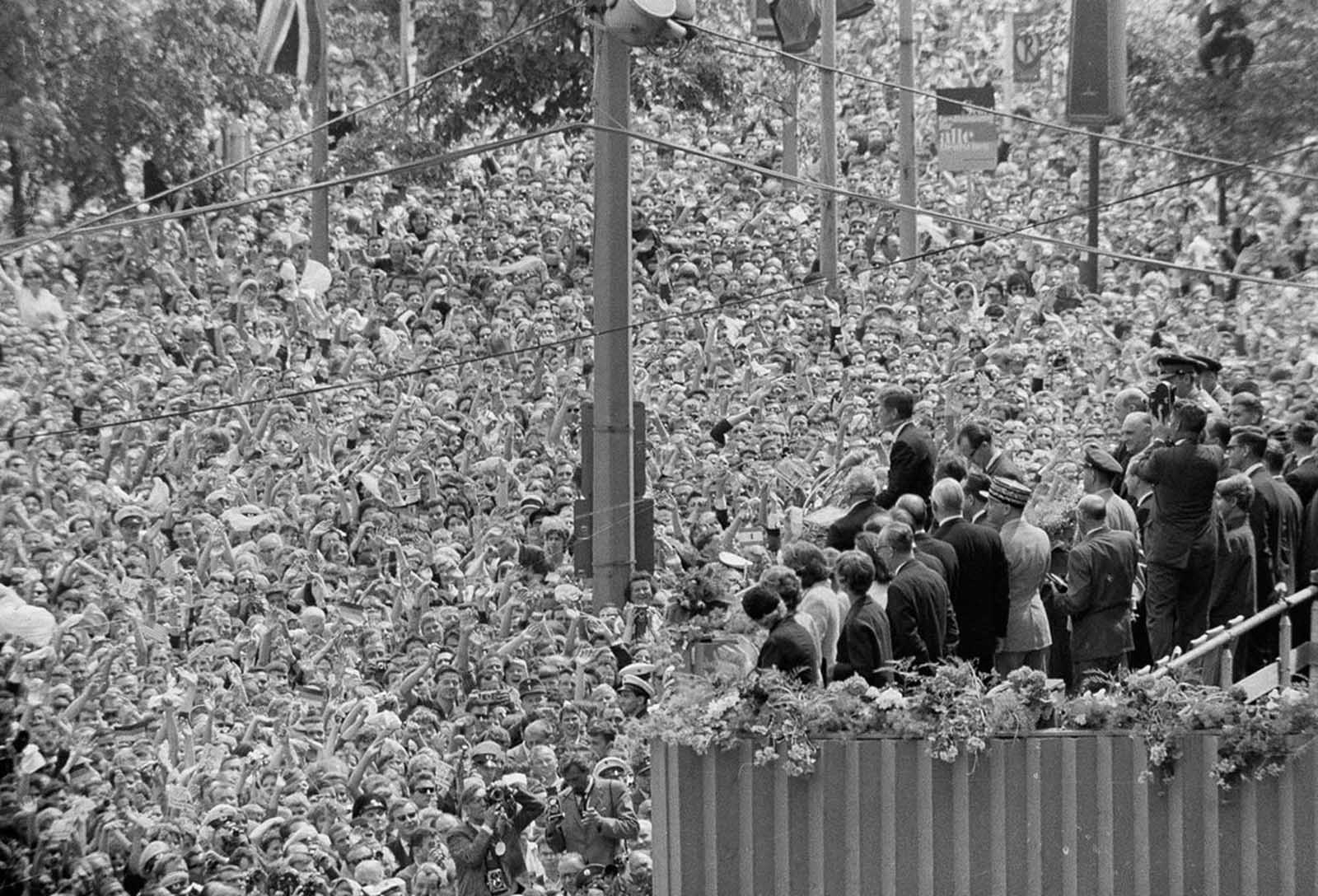
A cheering crowd, estimated by police at more than a quarter of a million, fills the area beneath the podium at West Berlin’s City Hall, where U.S. President John F. Kennedy stood. His address to the City Hall crowd was one of the highlights of his June 26, 1963 visit to West Berlin, where he received one of the greatest receptions of his career.
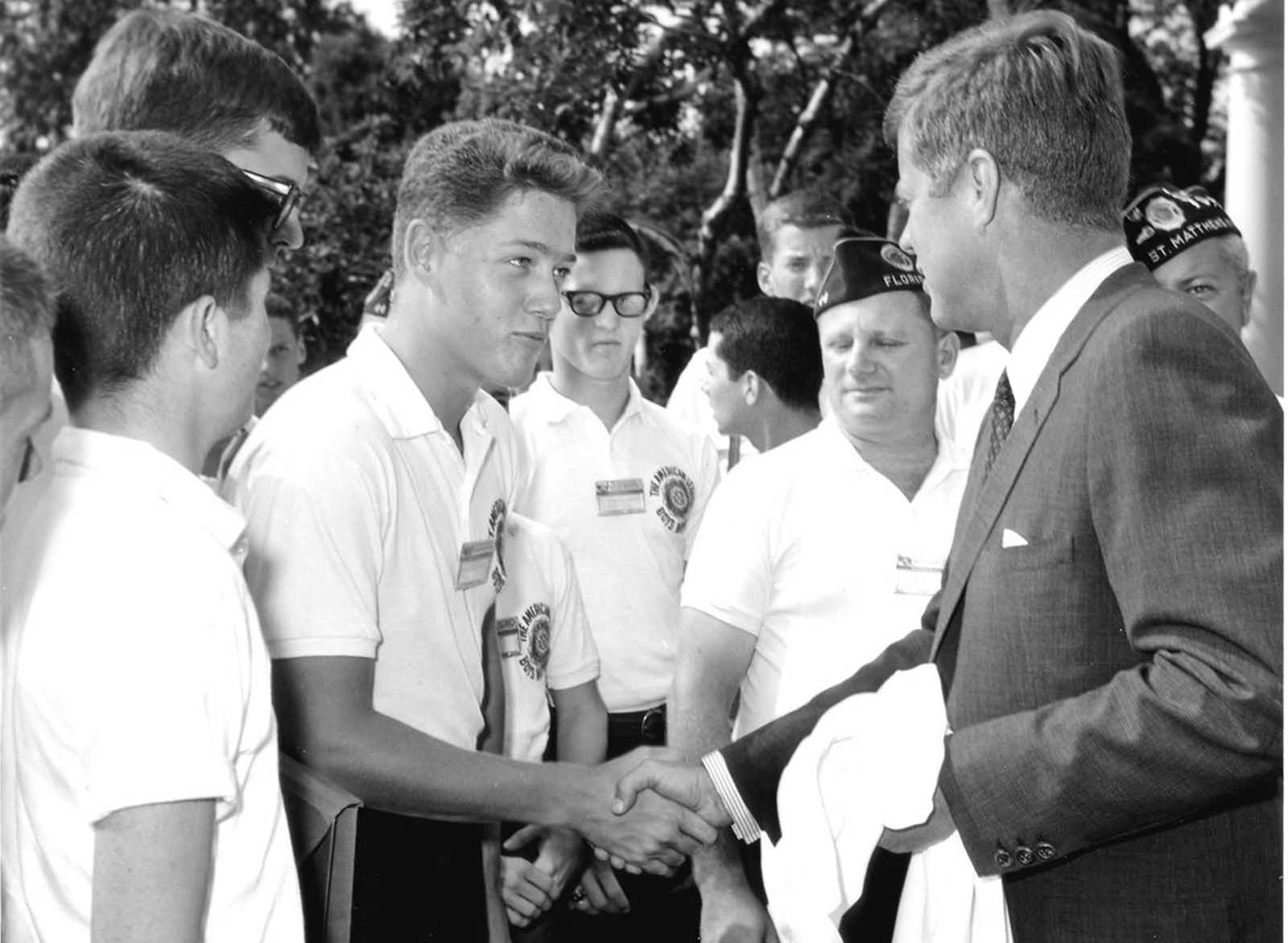
President Kennedy greets a 16-year-old Bill Clinton in the Rose garden of the White House at an American Legion Boys Nation event, on July 24, 1963.
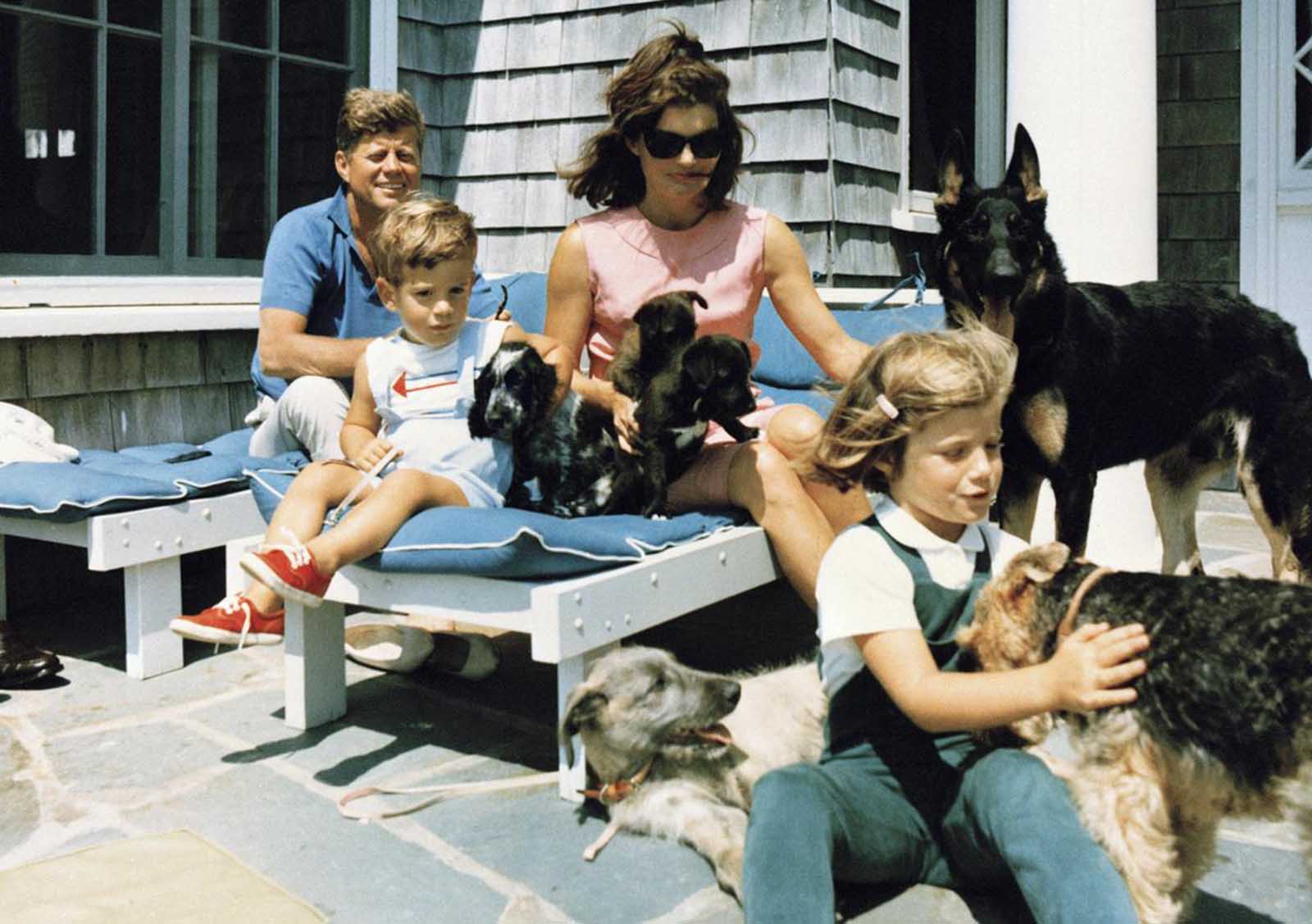
In this photo provided by the White House, President Kennedy, first lady Jacqueline Kennedy and their children, Caroline and John Jr., with the family dogs at their Hyannis Port, Massachusetts, home, on August 14, 1963.

President Kennedy takes his daughter Caroline out for a spin in the Honey Fitz, off Hyannis Port in August of 1963.
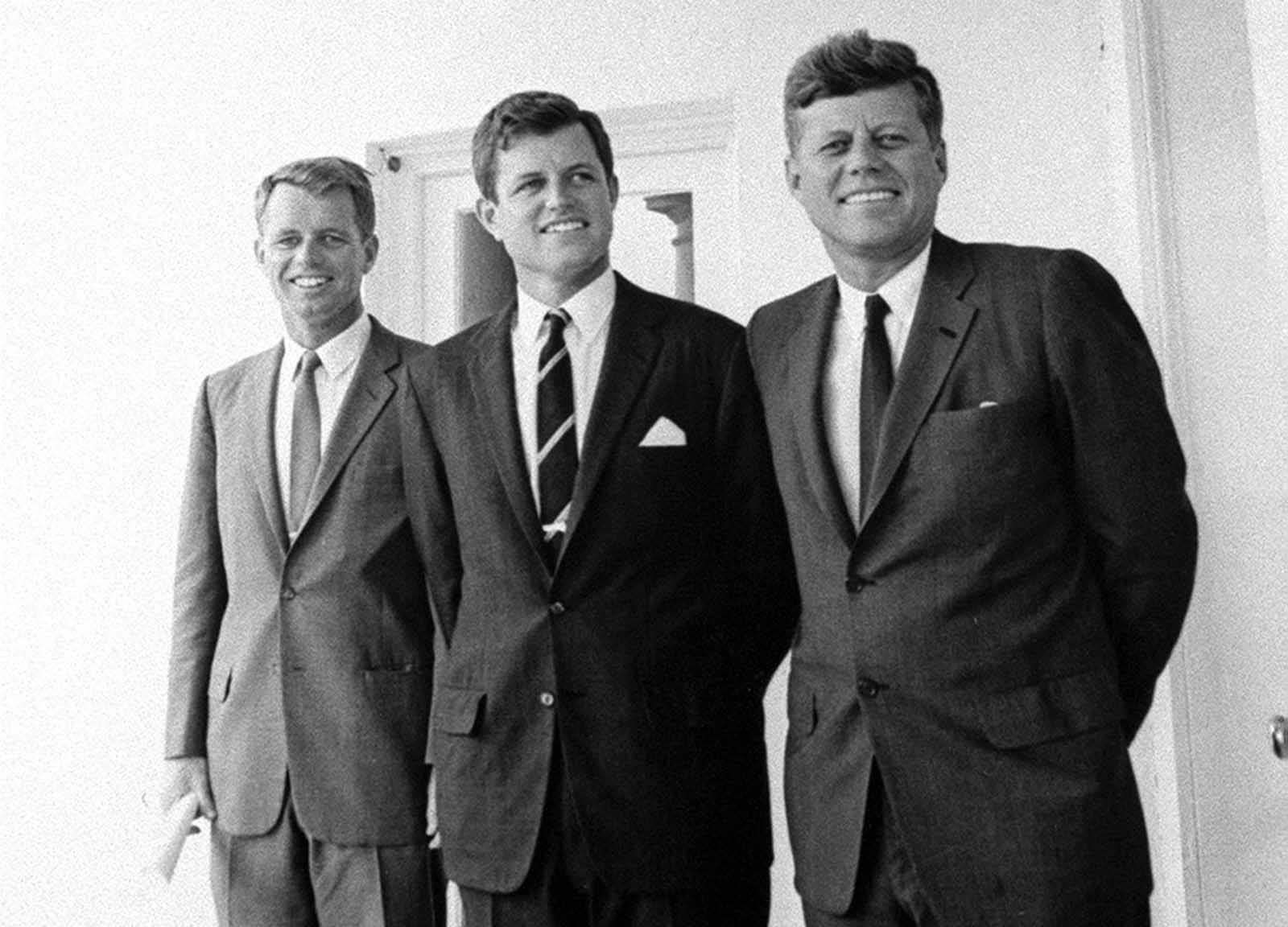
The Kennedy brothers, from left, Robert, Edward and President John F. Kennedy, pose together in August of 1963, in Washington D.C.

Aboard the USS Joseph P. Kennedy, Jr., named after the brother killed in World War II, President and Mrs. Kennedy watch the first race of the 1962 America’s Cup competition off Newport, Rhode Island.

This photo provided by John McInnis Auctioneers in Amesbury, Massachusetts, shows late President John F. Kennedy, right, with his wife, Jacqueline, center, and sister-in-law Ethel Kennedy at left. The photograph is among items that were auctioned on February 17, 2013.

President John F. Kennedy, wearing a windbreaker, watches through binoculars as a Polaris missile clears the surface after firing from a submerged nuclear sub off Cape Canaveral, Florida, on November 16, 1963.

On November 21, 1963, President John F. Kennedy and first lady Jacqueline Kennedy shake hands with well-wishers who lined the ramp at Houston International Airport to welcome them to the Texas city.

In this November 22, 1963 photo, President Kennedy and his wife, Jacqueline Kennedy, arrive at Love Field airport in Dallas, Texas.

President John F. Kennedy’s motorcade in Dallas, November 22, 1963.
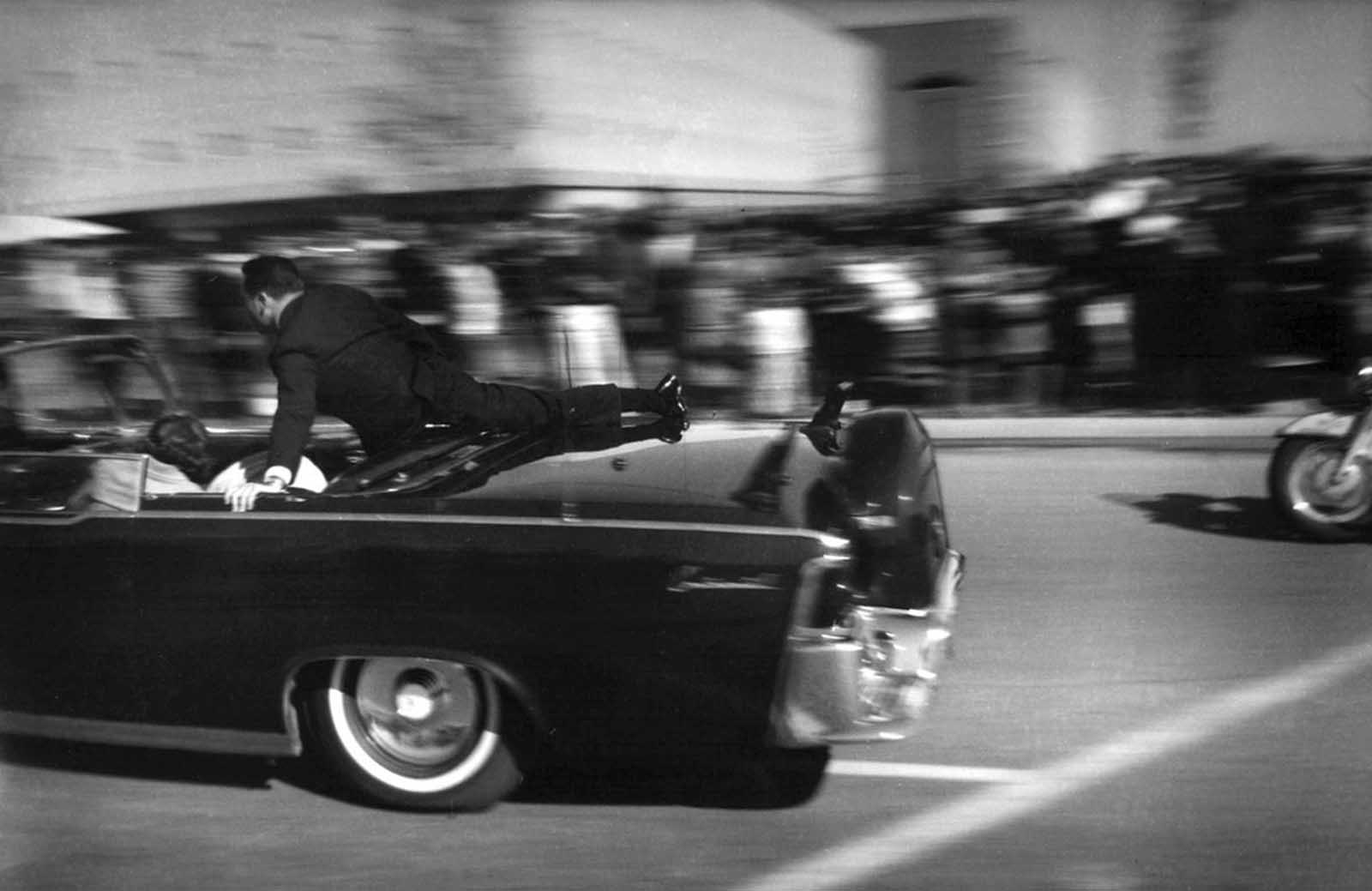
Seconds after shots rang out, the limousine carrying the mortally wounded President John F. Kennedy races toward the hospital in Dallas, Texas, on November 22, 1963. Secret Service agent Clinton Hill is riding on the back of the car, Nellie Connally, wife of Texas Gov. John Connally, bends over her wounded husband, and first lady Jacqueline Kennedy leans over the president.
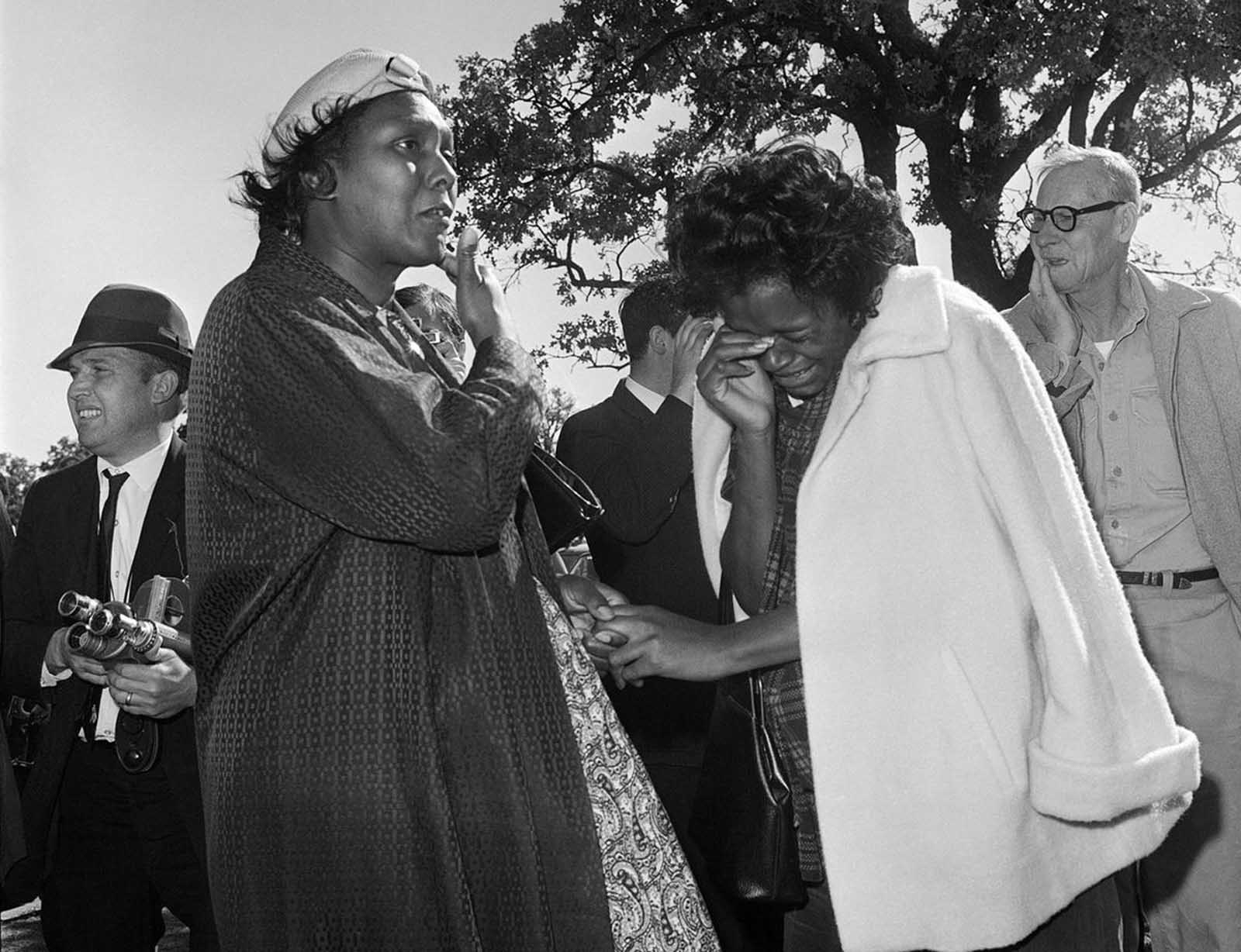
Women burst into tears outside Parkland Hospital upon hearing that President John F. Kennedy died from a gunshot wound while riding in a motorcade in Dallas, on November 22, 1963.
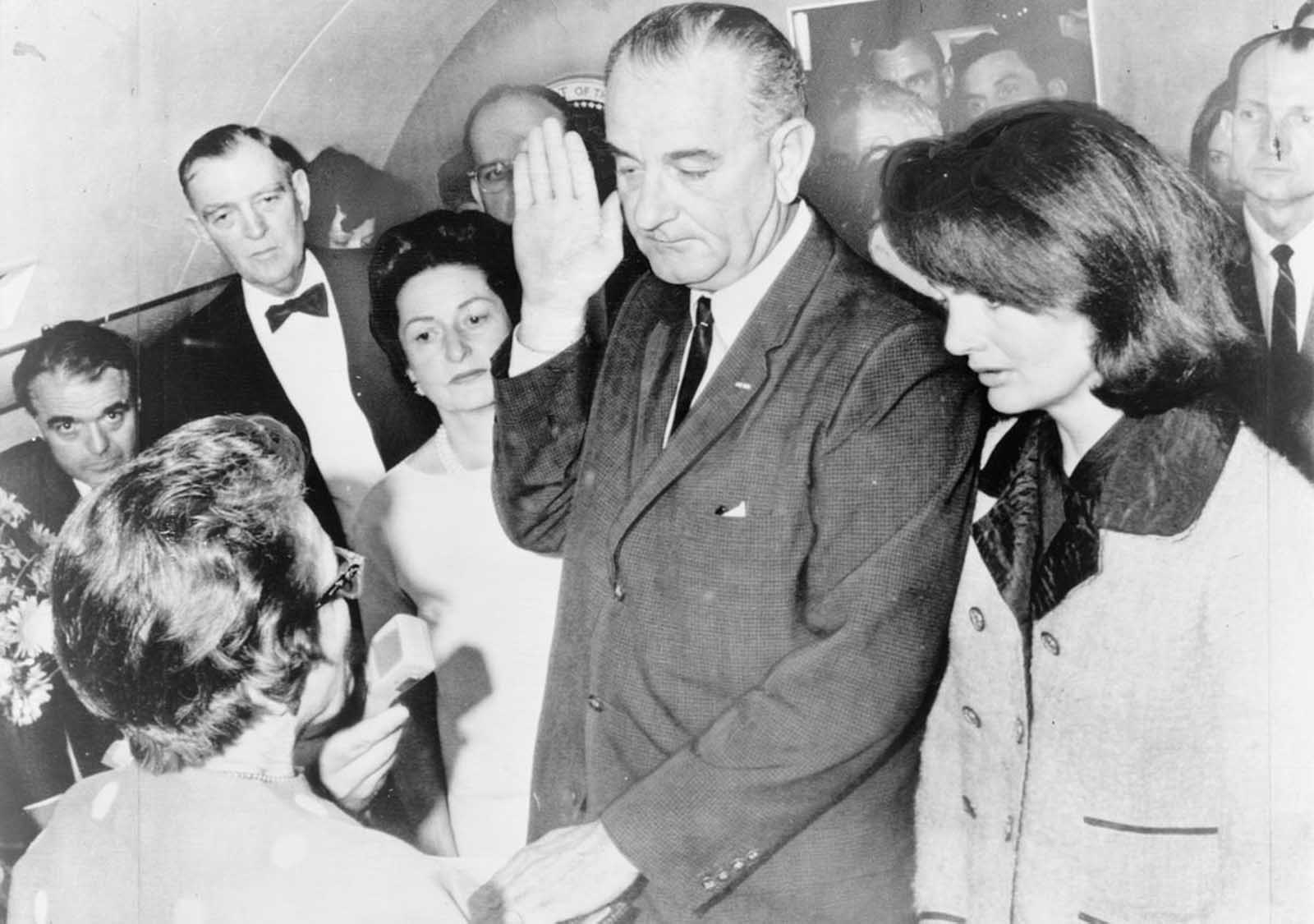
Lyndon B. Johnson is sworn in as President by Federal District Judge Sarah T. Hughes aboard the Presidential plane, as wife Lady Bird, former First Lady Jacqueline Kennedy and others look on.

People waiting for flights from Dallas at Love Field read the news of President John F. Kennedy’s assassination in the Dallas Times Herald newspaper, on November 23, 1963.

Kennedy’s casket lying in state in the East Room of the White house, before it was moved to the Capitol Rotunda.

With the illuminated U.S. Capitol in the background, mourners form an endless line which lasted through the night, to pay their respects to the slain President John F. Kennedy, in Washington, District of Columbia, on November 24, 1963.

Widow Jacqueline Kennedy kneels and reaches out to touch the casket of her slain husband, John F. Kennedy, in the rotunda of the Capitol in Washington, District of Columbia, on November 24, 1963. Their daughter Caroline kneels beside her.
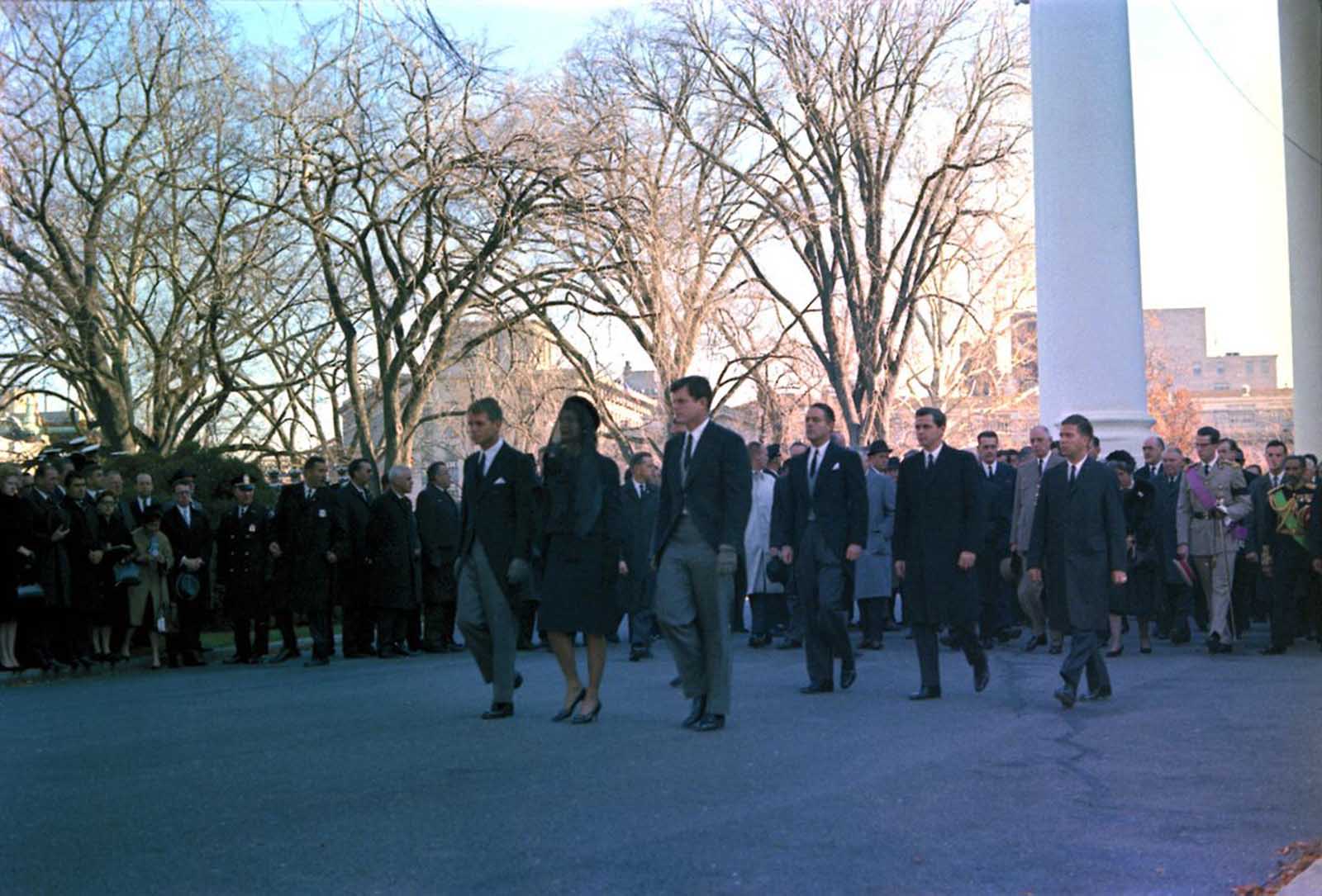
World leaders follow members of the Kennedy family in the funeral procession for the murdered president.
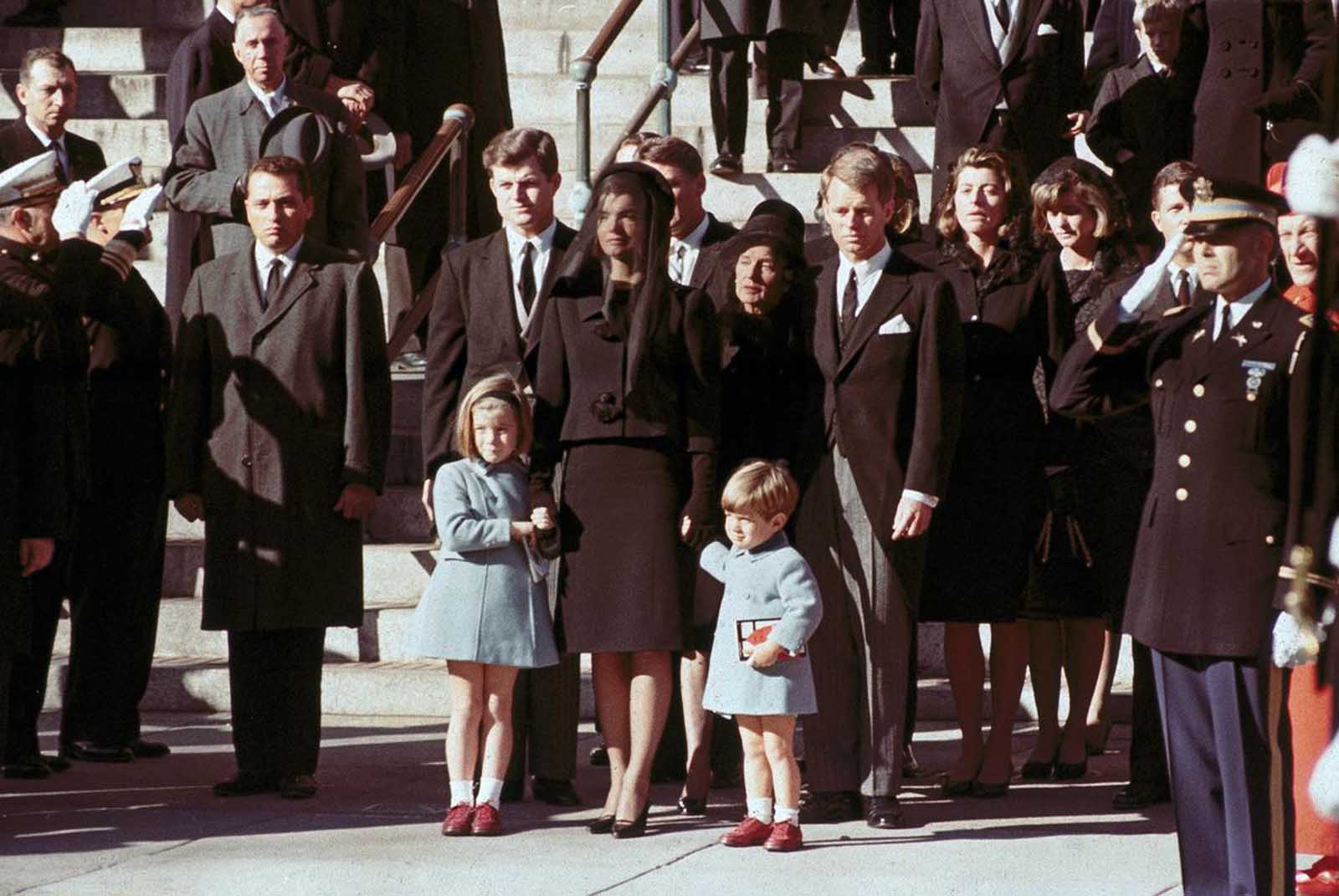
The First Family watches John F. Kennedy’s funeral procession in Washington on November 25, 1963, three days after the president was assassinated in Dallas. Widow Jacqueline Kennedy, center, daughter Caroline Kennedy, left, and son John Jr., are accompanied by the late president’s brothers Sen. Edward Kennedy, left, and Attorney General Robert Kennedy.
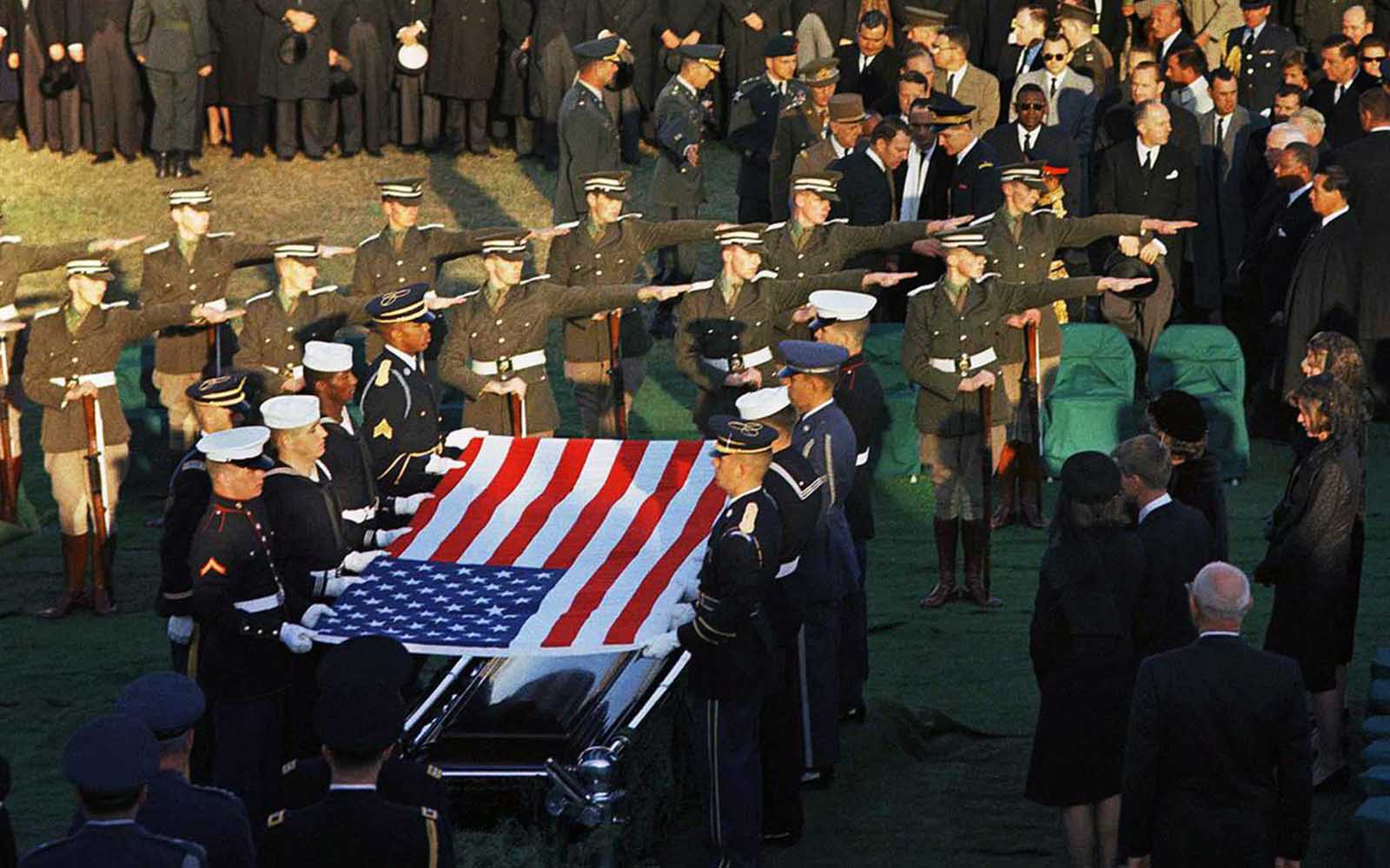
An Irish cadet honor guard, with arms outstretched, stand in formation as the U.S. flag is lifted from the coffin of President John F. Kennedy during his funeral services at Arlington National Cemetery in Arlington, Virginia, on November 25, 1963. The cadets, 18- and 19-year-old soldiers, had been whisked from their remote barracks in County Kildare the day before and were flown to the U.S. to perform a special ceremonial drill at the funeral of the slain president. He had been captivated by the drill when he saw it performed in Dublin months earlier.
Interesting facts:
Kennedy proposed a joint Soviet mission to the moon. Although Kennedy famously challenged the country in the first months of his presidency to land a man on the moon by the end of the 1960s, by September 1963 he had such concerns about the space program’s high cost that he proposed partnering with the Soviet Union on a joint expedition to the moon. “Why,” he asked in an address to the United Nations General Assembly, “should man’s first flight to the moon be a matter of national competition? Why should the United States and the Soviet Union, in preparing for such expeditions, become involved in immense duplications of research, construction and expenditure?”
There were rumors that he considered dropping Lyndon Johnson from the 1964 ticket. With more than a year before the 1964 presidential election, rumors swirled that Kennedy was considering replacing Johnson as his running mate with Florida Senator George Smathers, North Carolina Governor Terry Sanford or another Democrat.
Kennedy’s secretary, Evelyn Lincoln, wrote in her 1968 memoir that the president mentioned a possible switch to her three days before his death, and hours before the assassination, the November 22, 1963, edition of the Dallas Morning News printed an interview with Nixon, who was in the city on business, with the headline: “Nixon Predicts JFK May Drop Johnson.”
(Photo credit: AP Photo / Library of Congress).
